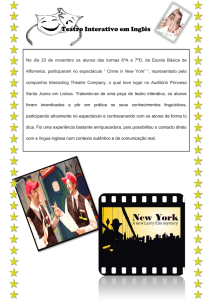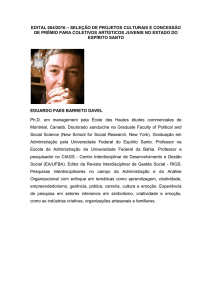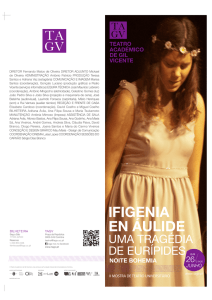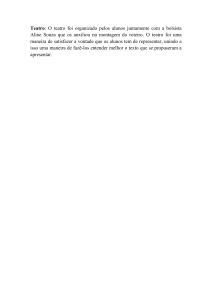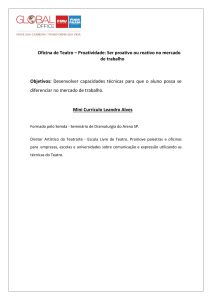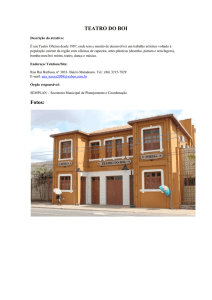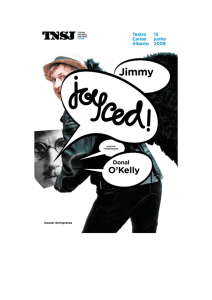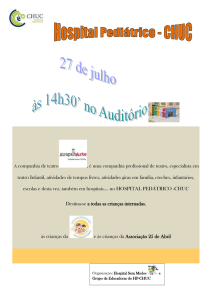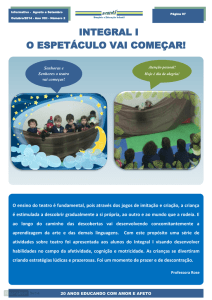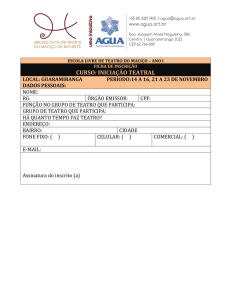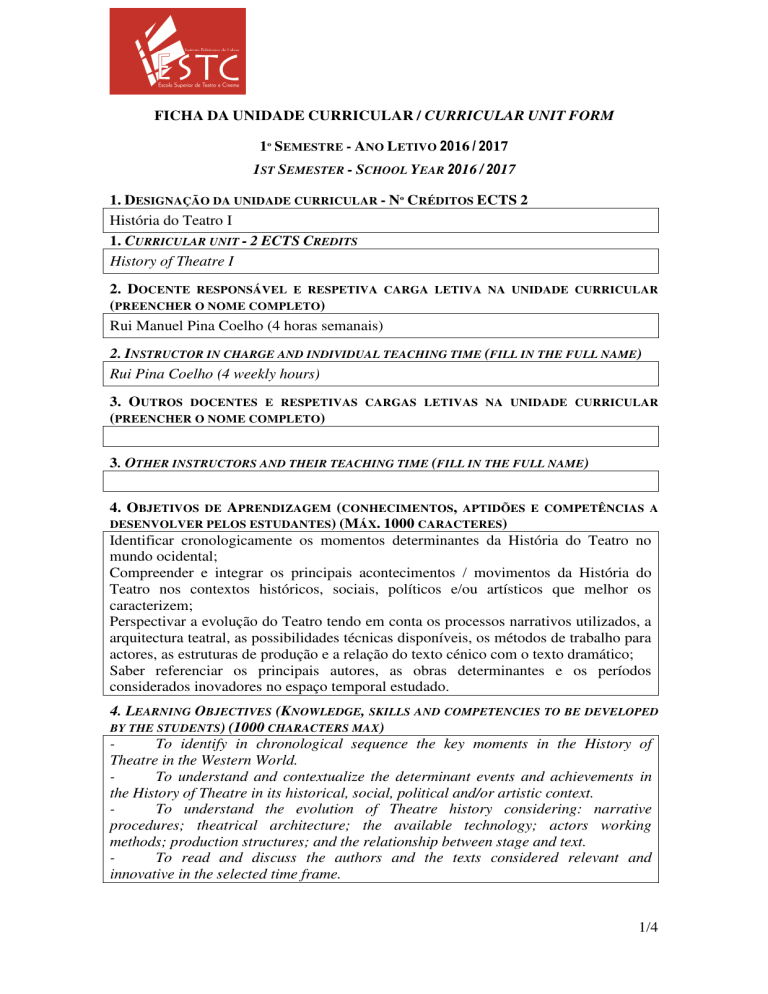
FICHA DA UNIDADE CURRICULAR / CURRICULAR UNIT FORM
1º SEMESTRE - ANO LETIVO 2016 / 2017
1ST SEMESTER - SCHOOL YEAR 2016 / 2017
1. DESIGNAÇÃO DA UNIDADE CURRICULAR - Nº CRÉDITOS ECTS 2
História do Teatro I
1. CURRICULAR UNIT - 2 ECTS CREDITS
History of Theatre I
2. DOCENTE RESPONSÁVEL E RESPETIVA CARGA
(PREENCHER O NOME COMPLETO)
Rui Manuel Pina Coelho (4 horas semanais)
LETIVA NA UNIDADE CURRICULAR
2. INSTRUCTOR IN CHARGE AND INDIVIDUAL TEACHING TIME (FILL IN THE FULL NAME)
Rui Pina Coelho (4 weekly hours)
3. OUTROS DOCENTES E RESPETIVAS
(PREENCHER O NOME COMPLETO)
CARGAS LETIVAS NA UNIDADE CURRICULAR
3. OTHER INSTRUCTORS AND THEIR TEACHING TIME (FILL IN THE FULL NAME)
4. OBJETIVOS
DE APRENDIZAGEM (CONHECIMENTOS, APTIDÕES E COMPETÊNCIAS A
DESENVOLVER PELOS ESTUDANTES) (MÁX. 1000 CARACTERES)
Identificar cronologicamente os momentos determinantes da História do Teatro no
mundo ocidental;
Compreender e integrar os principais acontecimentos / movimentos da História do
Teatro nos contextos históricos, sociais, políticos e/ou artísticos que melhor os
caracterizem;
Perspectivar a evolução do Teatro tendo em conta os processos narrativos utilizados, a
arquitectura teatral, as possibilidades técnicas disponíveis, os métodos de trabalho para
actores, as estruturas de produção e a relação do texto cénico com o texto dramático;
Saber referenciar os principais autores, as obras determinantes e os períodos
considerados inovadores no espaço temporal estudado.
4. LEARNING OBJECTIVES (KNOWLEDGE, SKILLS AND COMPETENCIES TO BE DEVELOPED
BY THE STUDENTS) (1000 CHARACTERS MAX)
To identify in chronological sequence the key moments in the History of
Theatre in the Western World.
To understand and contextualize the determinant events and achievements in
the History of Theatre in its historical, social, political and/or artistic context.
To understand the evolution of Theatre history considering: narrative
procedures; theatrical architecture; the available technology; actors working
methods; production structures; and the relationship between stage and text.
To read and discuss the authors and the texts considered relevant and
innovative in the selected time frame.
1/4
5. CONTEÚDOS PROGRAMÁTICOS (MÁX. 1000 CARACTERES)
O Teatro e a Cidade
O Teatro Clássico Greco-Latino
do mito às origens
o
análise e discussão de Rei Édipo, de Sófocles; e de O soldado fanfarrão, de
Plauto
O Teatro Medieval: mistérios, milagres, moralidades. A farsa
o mundo às avessas, o cómico, o religioso e o profano
o
análise e discussão de Amorosos, três farsas medievais francesas de autores
anónimos, versão original de JVLemos
O Renascimento e o Teatro em Itália
o arquitecto e o actor: o palco italiano da Renascença e a commedia dell’Arte
O Mundo Vicentino e o Palco Isabelino
o teatro de Gil Vicente (c.1465-1536); o teatro de William Shakespeare (15641616) e seus contemporâneos
o
análise e discussão de Alma, de Gil Vicente; e de Hamlet, de William
Shakespeare.
5. SYLLABUS (1000 CHARACTERS MAX)
Theatre and the City.
Greek and Roman Theatre: From myth to origins. Oedipus the King, by Sophocles;
and Miles Gloriosus, by Plautus.
Medieval Theatre: From liturgical drama to the farce. The World upside down, the
comic, the religious and the profane. Os amorosos [Lovers], three medieval French
farces by anonymous authors (original version by J.V. Lemos)
Italian Renaissance: The architect and the actor: Italian Renaissance stage and
commedia dell’Arte.
The Vicentine World and the Elizabethan Stage: The theatre of Gil Vicente (c.14651536); and the theatre of William Shakespeare (1564-1616) and its contemporaries.
Alma [Soul], by Gil Vicente; and Hamlet, by William Shakespeare.
6. DEMONSTRAÇÃO
DA COERÊNCIA DOS CONTEÚDOS PROGRAMÁTICOS COM OS
OBJETIVOS DA UNIDADE CURRICULAR (MÁX. 1000 CARACTERES)
Se tradicionalmente a História do teatro compreendia essencialmente o estudo e a
análise de textos dramáticos, considerados – nas propostas mais radicalizadas - como
objectos literários menores, e assim observando um ramo dos estudos literários, para
os modernos Estudos de Teatro a História do Teatro é uma disciplina de grande
fertilidade e, simultaneamente, complexidade. Fértil no sentido em que faz congregar
uma série de instrumentos de análise provenientes de vários campos do saber; e
complexa na medida em que é uma disciplina de apoio e ao serviço do praticante
teatral, bem como uma disciplina de investigação científica com domínios e propósitos
próprios. Assim, o programa desta UC visa dotar o aluno de um conjunto de
competências e conhecimentos que sejam facilitadores de uma aprendizagem mais lata
e, simultaneamente, garantir a aquisição de estratégias de investigação capazes de ser
aplicadas a outros conteúdos.
6. PROOF OF COHERENCE BETWEEN THE SYLLABUS AND THE LEARNING OBJECTIVES
(1000 CHARACTERS MAX)
If traditionally the history of theatre comprehends essentially the study and the
analysis of theatre texts, considered – in its most radicalized approaches – to be minor
objects in the field of literary studies, modern theatre studies are a discipline of great
2/4
fertility and complexity. Fertile in the sense that it congregates a series of instruments
of analysis from many different fields of knowledge; and complex in the sense it is a
discipline that supports and serves the theatre practitioner, as well as it is a discipline
of scientific research with precise goals and objectives. Thus, the contents if this UC
envisages to give the student a set of competences and knowledge’s that may facilitate
a broader learning and, simultaneously, to ensure the acquisition of research and
investigation methods able to be applied to other contents and contexts.
7. METODOLOGIAS DE ENSINO (AVALIAÇÃO INCLUÍDA) (1000 CARACTERES)
Avaliação contínua: assiduidade, participação activa nas aulas, produção e
apresentação de trabalhos escritos individuais, realização de leituras extra-aula;
Um teste de avaliação escrita, presencial e individual. Leitura, reflexão e debate de
textos fundamentais para a área disciplinar e produção escrita de trabalhos individuais.
Elaboração de um trabalho escrito sobre uma obra dramática produzida dentro do
período temporal estudado. Sempre que o interesse e a pertinência o justifique, as aulas
serão complementadas com a assistência a espectáculos de teatro ou de outras artes
performativas, bem como com idas pontuais a outros eventos relacionados com o
presente programa (colóquios, palestras, encontros, etc.).
7. TEACHING METHODS (INCLUDING ASSESSMENT) (1000 CHARACTERS MAX)
Continuous assessment: assiduity, active participation in classes, writing and
presentation of individual essays. One individual Written test. Reading, reflecting and
debating on fundamental texts for the UC. Writing a long essay on one play written
during the temporal frame of the UC. Every time interest and pertinence justifies it,
classes will be complemented with theatre performances, exhibitions, seminars,
congresses, etc.
8. DEMONSTRAÇÃO
DA COERÊNCIA DAS METODOLOGIAS DE ENSINO COM OS
OBJETIVOS DE APRENDIZAGEM DA UNIDADE CURRICULAR (MÁX. 3000 CARACTERES)
O método de ensino aprendizagem nesta disciplina prevê uma articulação entre uma
componente teórica leccionada em aulas expositivas e uma componente aplicada,
essencialmente constituída por aulas de debate e de discussão aberta dos textos
estudados, destinados a capacitar o aluno para uma leitura pessoal, estruturada e
organizada dos materiais apresentados. A realização de um trabalho escrito ao longo
do semestre permitirá uma melhor adequação dos discursos individuais e a uma melhor
maturação dos conteúdos programáticos, bem como uma maior autonomização do
aluno, à criação de uma rotina de trabalho assente na discussão, escrita, rescrita e
avaliação. O estudo dos autores e dos textos seleccionados, para além de uma análise
dramatúrgica, serve para instrumento de análise para a compreensão da história do
teatro no que diz respeito a metodologias de trabalho de actor, arquitectura teatral,
relação entre autor e estrutura de produção, condicionantes técnicas disponíveis,
hierarquia laboral na estrutura de produção.
8. PROOF
OF COHERENCE BETWEEN THE TEACHING METHODS AND THE LEARNING
OBJECTIVES (3000 CHARACTERS MAX)
The teaching methods articulates a theoretical component lectured in expositional
lessons and an applied component, essentially constituted by debating and discussing
sessions, destined to capacitate the student for a personal, structured and organized
reading of the presented contents. The writing of an essay throughout the semester
permits a better adjustment of an individual speech to the full understanding of the
contents discussed, as well as a bigger autonomy of the student, the creation of a work
routine based on discussion, writing, re-writing and evaluating. The study of the
3/4
authors and of the selected texts, more than a dramaturgical analysis, serves as an
instrument to comprehend the history of theatre regarding actors training, theatrical
architecture, relation between authors and production structures and available
technology.
9. BIBLIOGRAFIA
PRINCIPAL
(MÁX. 1000
CARACTERES)
/ MAIN BIBLIOGRAPHY (1000
CHARACTERS MAX)
CARLSON, Marvin, Teorias do Teatro - Estudo Histórico-crítico dos gregos à
actualidade. São Paulo: UNESP, 1997.
FISCHER-LICHTE, Erika, History of European Drama and Theatre. London and New
York: Routledge, 2002.
HARTNOLL, Phyllis, The Theatre – a concise history. London: Thames and Hudson,
1998.
MOLINARI, Cesare, História do teatro. Lisboa: Edições 70, 2010.
NAGLER, A.M., A Source Book in Theatrical History. New York: Dover
Publications, 1952.
PANDOLFI, Vito, Histoire du Théatre. Vol. I-V. Verviers: Marabout Université, 1964.
PAVIS, Patrice, Dictionnaire du théâtre. Paris: Dunod, 1996 (trad. língua portuguesa
de J. Guinsbourg & Maria Lúcia Pereira, Editora Perspectiva, 1999).
VASQUES, Eugénia, O que é Teatro. Lisboa: Quimera, 2003.
WILES, David e DYMKOWSKI (Ed.), The Cambridge Companion to Theatre
History. Cambridge: CUP, 2013.
ZARRILLI, Phillip B. et al., Theatre Histories – an Introduction. London and New
York: Routledge, 2006.
10. OBSERVAÇÕES
Para cada um dos pontos do programa haverá bibliografia específica.
10. GENERAL REMARKS
4/4

